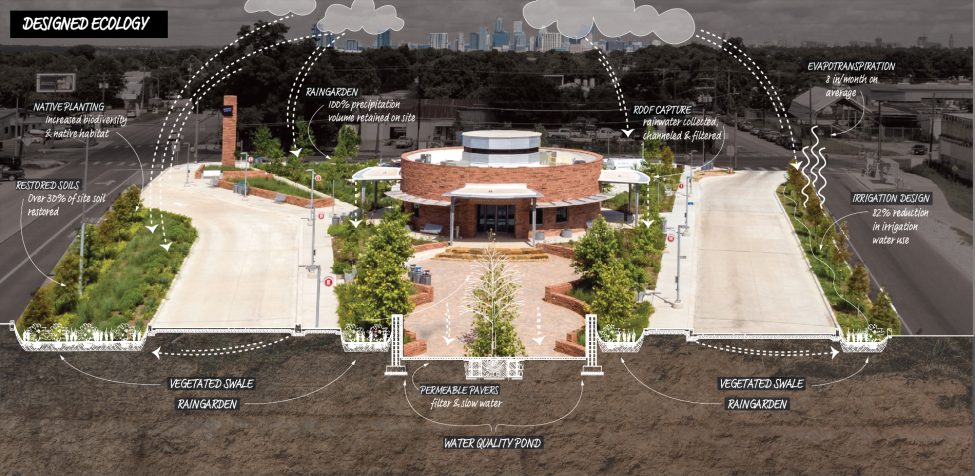
The Richard Moya Eastside Bus Plaza, once a nondescript road median, has undergone a remarkable metamorphosis into a thriving designed ecology sanctuary for both commuters and wildlife. Named after Richard Moya, the first Mexican American elected to public office in Austin, this plaza now stands as a vibrant testament to ecological restoration and community engagement, providing daily comfort to over 600 riders.
What is designed ecology?
“Designed ecology” is a concept that refers to the intentional design and management of ecosystems to achieve specific goals, often related to human well-being, environmental sustainability, and biodiversity conservation. It involves the application of ecological principles and knowledge in the planning, creation, and maintenance of landscapes, habitats, and built environments. What are some ways that we did this with the Richard Moya Eastside Bus Plaza?
The primary objective was to craft a functional and comfortable outdoor space with minimal impervious cover while effectively managing on-site stormwater runoff. Utilizing EPA-defined Best Management Practices (BMPs) like rain gardens, vegetated swales, detention ponds, and a permeable paving system, the project gained control over stormwater, slowing, filtering, and retaining water even during a 100th percentile precipitation event. Excavation for stormwater detention features, including basins for rain gardens and swales, provided greater control over total retention volume. These features, visually and physically accessible, double as amenities, engaging users with native plantings that stimulate the senses and contribute to water conservation.
The second goal focused on increasing biodiversity and establishing crucial natural habitat. Native plantings were carefully selected to promote seasonal variety and year-round interest. Bunch grasses, such as Little Bluestem, Big Bluestem, Indian Grass, Switchgrass, and Sideoats Grama, all characteristic of the Blackland Prairie, were blended with native perennial and blooming species. The result is a dynamic and aesthetically pleasing landscape designed to provide refuge, habitat, and diversity. Previously devoid of vegetation, the site now boasts 80 trees, over 3,600 shrubs, perennials, and grasses, along with 8,087 square feet of wildflower and Blackland Prairie. Large trees strategically placed across paved areas provide shade, offering respite from the intense Central Texas heat.
Despite being planted amidst the challenges of the winter storm of 2021 and the summer heat wave of 2022, the project’s native plant material thrived, attesting to the resilience of native plants. Soil restoration, a crucial aspect of the project, involved removing compacted and degraded topsoil, replacing it with locally sourced planting soil tailored to support native plant species. Post-construction tests verified the success of these efforts, measuring organic matter, infiltration, and soil biological function. The commitment to sustainable landscape maintenance ensures ongoing success as the site evolves over time.
The third goal aimed to provide economic and social benefits to the Eastside Bus Plaza’s immediate neighbors and the broader Austin community. The site features vegetated seating areas for solitude and expansive central spaces for group gatherings. Public amenities, strategically scattered across the plaza, enhance accessibility and enjoyment, while shaded nooks within planting beds create retreats for relaxation. These intimate spaces promote a connection to the surroundings and showcase the naturalized stormwater detention features on site. The terminal building, situated at the center, provides views and access to lush plantings and water features, contributing to the mental health and well-being of users.
The Richard Moya Eastside Bus Plaza stands as a compelling case study in “Deigned Ecology” which includes transformative urban design, seamless integration of ecological resilience, community engagement, and sustainable practices. From stormwater management to biodiversity enhancement and social connectivity, each element reflects a thoughtful approach to creating a harmonious intersection of functionality, ecology, and community well-being.